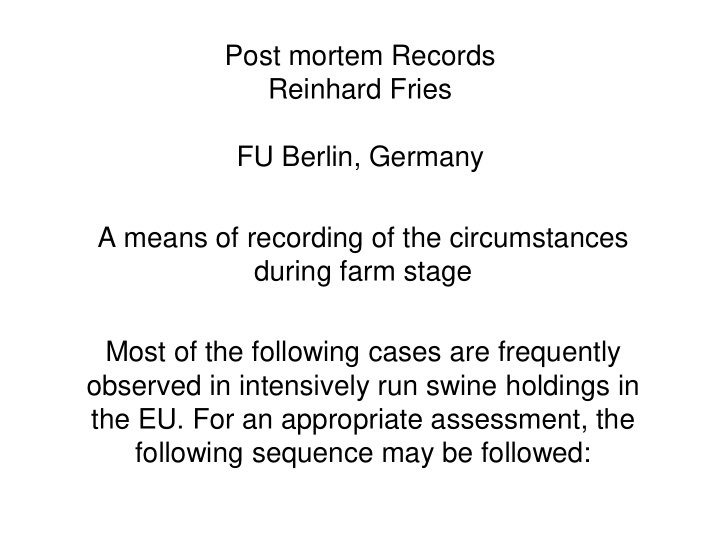



Post mortem Records Reinhard Fries FU Berlin, Germany A means of recording of the circumstances during farm stage Most of the following cases are frequently observed in intensively run swine holdings in the EU. For an appropriate assessment, the following sequence may be followed:
1. Basics • Recognition of the lesion • Denomination of the pathological case • Association with possible causes leading to this observation
2. Definitions needed Infection: Entry of an agent into a host Incubation time: Time between infection and the clinical manifestation of the respective disease Disease: The clinical appearance in the host caused by this infection Technopathy: Observation caused by technical equipment or other non-infectious influences from the environment of the animals (herd related)
3. Assessment • Having done the necropsy, the observation should be assessed for it’s possible risks for humans or animals. • The case studies to be discussed here, are in the order of this decision tree, which should be used.
1. The Infection 1.1. Local infection: Complication of a local event
Case 34: Lymphnode enlarged indicating action in the local tissue
• Case 1 Enteritis
Case 29: Unhygienic Keeping Conditions: Ascaris suum
• Case 2 Nephritis
Case 3: Pneumonia Suspected causative agent: APP
• Case 4 • Inflammation hind leg
• Case 5: Gonitis
• Case 6: Arthritis
Case 7: Pneumonia
• Case 8: Inflammation
Case 30: Pericarditis plus enlarged lymphnode
Case 30a: Heavy pericarditis
Discussion Plucks • Lungs: Pneumonia/ Pleurisy/ Pericarditis- Complex Herz • Pericarditis ist vor allem durch Pneumonie-Erreger bedingt • Endocarditis andere Erreger als Ursache hat (S. suis; E. rhusiopathiae)
• Case 9 Abscesses
Summing up • Case 1 Enteritis • Case 2 Nephritis • Case 3 Pneumonia • Case 4 Inflammation hind leg • Case 5 Gonitis • Case 6 Arthritis • Case 7 Pneumonia • Case 8 Inflammation • Case 9 Abscesses
For discussion
1.2. Systemic infections: Infection leading to a systemic reaction (disease)
Case 10: Gonitis / pleuritis
Case 11 PSE/ pleuritis / nephritis
• Case 12 Leucosis
• Case 13 Dermatitis
• Case 14 Icterus
• Case 15 Abscesses
• Case 16 Dermatitis including impact on muscles
• Case 17 Erysipelas
• Case 18 Leucosis
Case 31: Mandibularlymphnodes indicating presence of Mycobacterium avium intracellulare complex
• Case 19 Trichinella
• Case 20 Strugglers
For discussion
2. Non infectious 2.1. Individual cases
Case 21: Abscesses caused by tail biting
Case 33: Abscesses
Case 33: Abscesses
• Case 22 Spleen blood jam
• Case 23 Blow caused lesion
Case 32: Fracture Pig (during lifetime)
2.2. Herd level leading to technopathy
• Case 24 Decubital lesion
• Case 25 Decubital lesion
Case 26 Tailbiting caused necrosis
Summing up • Case 21 Abscesses caused by tail biting • Case 22 Spleen blood jam • Case 23 Blow caused lesion • Case 24 Decubital lesion • Case 25 Decubital lesion • Case 26 Tailbiting caused necrosis
For discussion
3. Breeding & Genetics with consequences for the individual lifetime
Case 27 M. longissimus dorsi and suspicion of necrosis (PSE syndrome)
For discussion
4. Complication of single cases Frequently, certain given circumstances lead to a cascade of reactions: Under the influence of (adverse) environments, the animal reacts and suffers from different aches or other.
Note • Carcass & Organs • Each site should be observed consciously and carefully. • In all, the over all appearance is another important thing, indicating an „complication“ of a single lesion, e.g. – nutrition state, – symmetry, – shape •
• Case 1 • Case 10 • Case 11 • Case 16 • Case 20 • Case 28
Case 28: Hind leg & Lymphnodes
For discussion
4. Seizure and taking action as a consequence • Carcass or organs pass the inspection or they are going to be rendered, which depends on local reglement and legislation and which is not discussed here. • Important is an understanding of the lesion and the learning the reaction cascade. Only then, preventive measures may be taken. • With regard to the individual, any observation should be recorded as an indicator for the status of the group from “this farm of origin”.
Recommend
More recommend